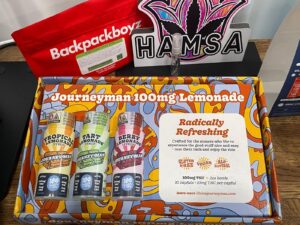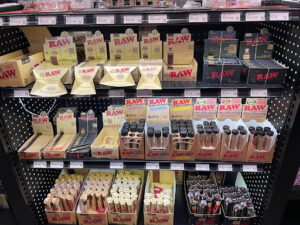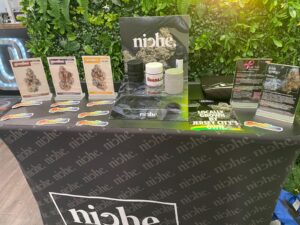Cannabis edibles are food- or drink-based products that deliver cannabinoids like THC through digestion, so their effects show up and fade differently than inhaled cannabis. This guide compares THC gummies to other edible formats across onset, duration, dosing accuracy, flavor, discretion, and safety to help you pick what works for your goals. Many readers want practical advice on dosing gummies, microdosing strategies, and which edible types suit beginners or specific diets. We cover pharmacokinetics (onset and duration), product attributes (mg per serving, shelf life, flavor), and safety checks like third‑party lab testing and packaging. You’ll also find quick comparison tables, clear lists for dosing and safety, and a short note about buying or having edibles delivered from a licensed Jersey City dispensary. Knowing these differences makes it easier to choose an edible that matches your experience level and desired outcome while reducing the chance of unwanted effects.
What Are THC Gummies and Why People Choose Them
THC gummies are small, flavored candies infused with a measured amount of THC so each piece delivers a predictable dose when eaten. They release THC into the digestive system where it’s metabolized, so effects usually begin later but last longer than smoking or vaping. Key benefits are easy dose control, discreet portability, and longer shelf life than many homemade treats, which is why gummies are a go‑to for both new and experienced users who want consistent results and simple storage.
Gummies are particularly beginner-friendly because labels usually state milligrams of THC per piece, making dose control straightforward. Commercial production lets manufacturers mix the THC evenly through the gummy base, reducing variability between pieces, and third‑party lab results help confirm labeled potency. Below we’ll outline what sets gummies apart from other edible formats so you can see where they shine and when another option might be better.
Practical advantages of THC gummies:
- Measured dosing per piece for predictable effects.
- Portable and discreet for on-the-go use.
- Longer shelf life and easier storage than fresh baked goods.
These benefits explain why people searching for “THC gummies Jersey City” are often looking for reliable, easy‑to‑dose edibles for recreation or symptom relief.
Why Gummies Stand Out Versus Other Edibles
Gummies are easy to standardize because manufacturers emulsify THC in a carrier oil and blend it evenly into the gummy mix, so each piece can contain a reliable milligram amount. Flavorings and sweeteners hide cannabis notes, which helps users who don’t enjoy the plant taste. Resealable, discreet packaging and pocketable formats make gummies convenient for everyday use, and those features tend to attract both beginners and intermediate users. Those manufacturing advantages lead directly into how consistent dosing is achieved and why lab testing matters topics we cover next.
How Gummies Deliver Reliable Doses and Consistent Effects
Gummies offer consistent effects because THC is mixed into a carrier oil and distributed evenly through the gummy matrix during production, so each piece contains a known mg amount. Third‑party lab tests verify cannabinoid levels and screen for contaminants like pesticides or solvents a transparency step shoppers should look for. Clear “mg THC per serving” labels let consumers plan conservative starters (2.5–5 mg) or standard doses for experienced users (about 10 mg). Reading labels and lab reports helps match potency to your goals and lowers the risk of accidental overconsumption. With labeling and testing in mind, let’s look at other edible forms and how they compare in use and effect.
THC Pharmacokinetics and Absorption in Edibles
The pharmacokinetics of THC absorption relate to THC’s lipophilic properties and how it’s processed in the digestive system [12].
Pharmacokinetic investigation of commercially available edible marijuana products in humans: potential influence of body composition and influence on …, TR Ewell, 2021
Common Edible Types Beyond Gummies
Edibles arrive in many formats chocolates, baked goods, beverages, lozenges, tinctures and more each with different preparation methods, onset timings, and taste profiles. Commercial chocolates and drinks can offer measured doses like gummies, while homemade baked goods often vary in potency because infusion is less precise. Beverages and tinctures may absorb differently depending on whether they’re swallowed or held under the tongue, which changes onset. Dietary options (vegan, sugar‑free, allergen‑free) also matter, and many brands now make products for specific needs.
Quick rundown of major edible categories and what distinguishes them:
- Chocolates: Rich, portioned pieces with labeled THC, familiar candy format for flavor-first users.
- Baked goods: Cookies and brownies can be potent and tasty but often lack consistent dosing unless produced commercially.
- Beverages: Can be engineered for faster absorption; discreet and low-odor compared with baking.
- Lozenges/Tinctures: Offer sublingual or slow oral absorption and can be easier to microdose for therapeutic goals.
How Chocolates, Baked Goods, and Drinks Differ from Gummies
Chocolates deliver a rich taste and can be portioned reliably when commercially made, though fat content affects absorption and onset. Homemade baked goods frequently show uneven cannabinoid distribution, making precise dosing difficult; they also spoil faster. Water‑soluble beverages can act faster in some formulas, differing from oil‑based gummies. If predictable dosing and shelf stability are priorities, gummies and commercial chocolates usually outpace homemade baked goods.
Taste, Shelf Life, and Discretion: What to Expect
Flavor varies: gummies and chocolates mask cannabis taste with sweet profiles, while baked items often keep stronger cannabis notes that some people dislike. Shelf life also changes sealed gummies and chocolates can last months if stored properly, while fresh baked goods typically last days. Discretion favors gummies and beverages because they resemble ordinary snacks or drinks and generate less aroma during preparation. If predictability and low profile matter most, gummies are usually the best pick; if ritual and flavor are key, consider a well-dosed chocolate or beverage.
Quick tip: choose gummies for discretion and measured dosing; choose a commercial chocolate or beverage when flavor and experience are the priority.
| Edible Type | Typical Dose Range (mg) | Taste/Profile | Shelf Life | Best Use Case |
|---|---|---|---|---|
| Gummies | 2.5–10 mg per piece | Sweet, fruity; masks cannabis | Months (sealed) | Beginners, dose control, travel |
| Chocolates | 5–20 mg per serving | Rich cocoa; masks taste | Months (sealed) | Flavor-focused users, gifting |
| Baked Goods | 10–50+ mg per serving | Homey; cannabis notes may be noticeable | Days (fresh) | Sharing, homemade treats |
| Beverages | 2.5–15 mg per serving | Neutral to sweet; low odor | Weeks–months (packaged) | Fast-onset formulas, discreet use |
How Gummies Stack Up on Effects and Use
The biggest pharmacokinetic differences come from formulation and how the product moves through digestion: onset, peak, and duration change with fat content, delivery matrix, and individual metabolism. Gummies and chocolates are usually oil‑based and tend to onset in 30–90 minutes, peak around 2–4 hours, and last roughly 4–8+ hours depending on dose and metabolism. Water‑soluble beverages can act faster in some cases, while baked goods may have slower, less predictable absorption. Knowing these timelines helps you pick the right edible for short sessions or longer relief.
Below is a side‑by‑side comparison of onset, duration, potency control, discretion, and shelf life to make choosing easier.
| Edible Format | Onset Time | Duration | Potency Control | Discretion |
|---|---|---|---|---|
| Gummies | 30–90 minutes | 4–8+ hours | High | High |
| Chocolates | 30–90 minutes | 4–8 hours | High | Medium |
| Baked Goods | 45–120 minutes | 4–10 hours | Low (variable) | Low |
| Beverages | 15–60 minutes (fast formulas) | 2–6 hours | Medium | High |
Onset, Duration, and Potency: What to Expect
Onset and duration depend on both the edible’s formulation and individual factors. High‑fat items like chocolate can slow gastric emptying and slightly change absorption, while water‑soluble drinks may enter circulation faster. Potency is measured in milligrams of THC per serving, but bioavailability how much THC reaches the bloodstream varies by matrix and metabolism. Practically, beginners typically start at 2.5–5 mg and wait at least two hours before increasing; experienced users often use 10–20 mg depending on tolerance and desired intensity. These ranges help match product choice to expected effects. Next we’ll look at how the user experience changes between gummies and other formats.
How User Experience Differs Between Formats
Experience depends on goals and context: beginners and medical users often prefer gummies for predictable dosing and controlled escalation, while social users who value flavor or sharing may opt for chocolates or baked goods. Someone wanting daytime microdosing for focus might use 2.5–5 mg gummies; someone seeking night‑time sleep support might pick a higher‑dose edible with sedating terpenes or an indica‑leaning profile. Ritual and social factors matter too baked goods feel communal, gummies are discreet and portable and those preferences shape which format will feel most satisfying. Next, we’ll offer a decision framework to match potency, dietary needs, and safety signals to your goals.
| Format | Attribute | Value |
|---|---|---|
| Gummies | Onset time | 30–90 minutes |
| Chocolates | Duration | 4–8 hours |
| Baked Goods | Potency control | Variable |
| Beverages | Discretion | High |
Key Factors to Weigh When Choosing THC Edibles
Choosing the right edible comes down to potency, dose control, desired effect, ingredients, dietary needs, and safety indicators like lab testing and child‑resistant packaging. Match mg‑per‑serving to your goal microdosing for subtle effects or higher doses for sleep or stronger symptom relief and always allow at least two hours before upping your dose. Check ingredient lists for allergens or dietary preferences (vegan, sugar‑free). Non‑negotiable safety signs include third‑party lab reports, clear serving labels, and child‑resistant packaging.
Use this practical checklist when comparing products before you buy.
- Confirm labeled THC mg per serving and choose a starter dose.
- Review third‑party lab results for potency and contaminants.
- Check ingredients and allergen info (vegan, gluten‑free, sugar‑free if needed).
- Look for child‑resistant packaging and clear serving guidance.
Following this checklist reduces uncertainty and helps you choose edibles that align with both recreational and therapeutic goals; next we’ll cover dosing guidance and ingredient considerations in more detail.
How Potency and Dose Shape the Experience
Potency and dose determine intensity and duration: small doses (2.5–5 mg) usually produce mild relaxation or subtle effects, moderate doses (10–20 mg) create stronger intoxication for many users, and higher doses raise the risk of adverse reactions for inexperienced consumers. Let desired effects guide product choice microdosing for daytime focus, moderate doses for social relaxation, and higher doses for sleep or deeper symptom relief. Tolerance and frequency of use matter too; regular users often need higher mg for the same effect. Start low and increase slowly while tracking outcomes.
Ingredient and dietary choices are the next piece of the puzzle.
Ingredients, Dietary Needs, and Safety Considerations
Ingredients affect suitability: look for vegan gummies, sugar‑free formulas, or products without common allergens if you have dietary restrictions. Other cannabinoids (CBD or minor cannabinoids like HHC) can change the overall feeling through entourage effects, so check labels. Safety markers include third‑party lab testing, standardized packaging, and regulated sourcing these reduce contamination risk and support consistent potency. When unsure, ask knowledgeable dispensary staff to help interpret lab reports and ingredient lists before buying.
Below is a short comparison table to match edible types with dose ranges, taste, shelf life, and best use cases handy when balancing dietary needs and safety.
| Entity | Typical Dose Range (mg) | Taste/Profile | Shelf Life | Best Use Case |
|---|---|---|---|---|
| Gummies | 2.5–10 | Fruity, sweet | Months | Microdosing, travel |
| Chocolates | 5–20 | Cocoa-rich | Months | Flavor-first users |
| Baked Goods | 10–50+ | Homemade, variable | Days | Sharing, novelty |
| Beverages | 2.5–15 | Neutral or sweet | Weeks–months | Fast-acting formats |
Edible Options at Uforia Dispensary in Jersey City
Uforia Dispensary is a licensed Jersey City retailer carrying a broad selection of cannabis products edibles, flower, and concentrates with an emphasis on quality, safety, and customer education. Local shoppers will find premium edibles like THC gummies and branded chocolates, plus staff on hand to explain potency, dosing, and lab reports. Uforia offers in‑store pickup and delivery, and a loyalty rewards program for returning customers. Our goal here is to inform local buyers, support safe purchase choices, and help build repeat customers through clear education.
Here’s a quick map of edible categories we typically stock and what to expect when shopping with us.
| Product Category | Example Product/Brand | Typical Dosage | Buying Options (in-store/delivery) | Quality Assurance |
|---|---|---|---|---|
| Gummies | Premium commercial gummies | 2.5–10 mg per piece | In-store, delivery | Third-party lab-tested, regulated sourcing |
| Chocolates | Branded THC chocolates | 5–20 mg per serving | In-store, delivery | Lab reports available, sealed packaging |
| Baked Goods | Locally sourced commercial baked items | Variable | In-store | Vendor verification, freshness checks |
| Beverages | Packaged cannabis drinks | 2.5–15 mg per can | In-store, delivery | Batch testing, clear labeling |
How Uforia Keeps Its Edibles Safe and Reliable
We prioritize compliance and vetted brands to protect customers: every edible we recommend has clear labels and third‑party lab testing that confirm THC per serving and screen for contaminants. Our staff review supplier certificates to verify potency and safety. Packaging is sealed and child‑resistant, with ingredient and allergen panels to support safe storage and use. These practices reduce risk, improve predictability, and reflect best practices for edible retail in Jersey City.
How Our Team Helps You Pick the Right Edible
Uforia’s team guides customers on potency, dosing strategies, ingredient needs, and safe microdosing for daytime use or symptom management. We can walk you through lab reports, point out vegan or sugar‑free gummy options, and recommend products suited to beginners or experienced users. Staff also explain delivery options and how our loyalty program rewards repeat purchases. For personalized advice, stop by the store or use Uforia’s delivery coordination to match an edible to your intended effect and safety requirements.
These services support safer consumption, which we outline in the next section.
How to Use THC Gummies and Other Edibles Safely
Safe edible use depends on conservative dosing, patience for onset, safe surroundings, and awareness of interactions with medications or alcohol. The core rule is “start low, go slow”: begin with a low dose (2.5–5 mg THC) and wait at least two hours before taking more to judge full effects. Microdosing small, regular doses spread across the day can deliver symptom relief without heavy intoxication. Store edibles in original, child‑resistant packaging away from children and pets, and check third‑party lab tests to confirm contents and the absence of contaminants.
Essential safety tips for edible use:
- Start with a low dose and wait at least two hours before adding more.
- Keep edibles in original, clearly labeled packaging and store securely.
- Avoid mixing edibles with alcohol or other sedatives; consult your healthcare provider about medication interactions.
- Track doses and effects in a simple log to refine microdosing and prevent overconsumption.
These steps lower risk and increase the chance of a controlled, positive experience; next we outline microdosing schedules and escalation guidance.
Best Practices for Starting Doses and Microdosing
Start at 2.5–5 mg of THC for a single session if you’re inexperienced or sensitive, and wait at least two hours to assess effects before increasing. For microdosing, small increments of 1–2.5 mg spaced through the day can provide subtle benefits like mild anxiety relief or steady mood without strong intoxication. Test doses under consistent conditions (same food intake and environment) to better evaluate effects, and keep a short log of subjective responses. If you have health concerns or take medications, consult a healthcare professional before beginning a regular edible routine.
These practices help avoid common side effects, explained next.
How to Avoid Common Side Effects and Have a Positive Session
To reduce anxiety, nausea, or excessive sedation: stay hydrated, eat a light meal if fasting makes you more sensitive, and don’t mix edibles with alcohol or other CNS depressants. If an edible feels stronger than expected, remain calm, hydrate, rest in a safe place, and remember symptoms will fade over time. If you see severe warning signs confusion, loss of consciousness, or breathing difficulties seek emergency help. Report adverse events to the retailer or regulators when appropriate, and stick to products with transparent lab reports to lower contaminant risks.
For Jersey City residents who want guidance or reliable, tested edibles, Uforia’s staffed store and delivery service provide convenient access plus loyalty benefits to support safer, informed purchasing.
| Product Category | Example Use Case | Safety Feature |
|---|---|---|
| Gummies | Beginner microdosing | Clear mg labeling, lab results |
| Chocolates | Flavor-focused dosing | Sealed packaging, batch testing |
| Beverages | Discreet, rapid formats | Ingredient transparency |
| Baked Goods | Social sharing | Vendor freshness verification |
Residents of Jersey City can consult Uforia Dispensary’s knowledgeable staff for product recommendations, use in‑store pickup or delivery for convenience, and join our loyalty program to support repeat, safer purchases while keeping education and safety front and center.
Frequently Asked Questions
1. What’s different about the effects of THC gummies versus other edibles?
Gummies usually offer a more predictable, consistent experience than homemade baked goods or some chocolates. Effects commonly start in 30–90 minutes and last 4–8 hours depending on dose. Baked goods can have slower or more variable onset because cannabinoid distribution may be uneven, while certain beverages can act faster. Knowing these differences helps you time consumption for the experience you want.
2. How do I pick the right THC gummy dose?
Start low and go slow. Beginners often begin at 2.5–5 mg THC and wait at least two hours to assess effects before increasing. Experienced users might consider 10–20 mg depending on tolerance. Consider personal sensitivity, the situation, and whether you want a subtle or strong effect when choosing a starting dose.
3. Should I consider dietary restrictions when choosing edibles?
Yes. Many brands offer vegan, gluten‑free, or sugar‑free edibles. Always read ingredient labels to avoid allergens and confirm the product matches your dietary needs. Also check for added cannabinoids or ingredients that could alter the effect.
4. What safety steps should I follow when taking edibles?
Use caution: start with a low dose and wait at least two hours before adding more. Keep edibles in original, labeled packaging and out of reach of children and pets. Don’t mix with alcohol or other sedatives, and consult a healthcare provider if you have concerns about drug interactions.
5. How can I tell if a THC gummy is high quality?
Look for third‑party lab testing that verifies potency and screens for contaminants. Quality products will show clear mg per serving on the label and come in child‑resistant packaging. Reputable brands often make lab reports available for review.
6. Can THC gummies be used medicinally?
Yes. Many people use gummies for chronic pain, anxiety, sleep, or other symptoms because of precise dosing and longer‑lasting effects. Always consult a healthcare professional before starting a cannabis regimen, especially if you take other medications or have medical conditions.
7. What should I check when buying gummies from a dispensary?
Consider potency, ingredient transparency, and safety features. Check third‑party lab results for cannabinoid content and contaminants, review packaging for child resistance and clear serving instructions, and ask staff for recommendations to match products to your needs.
Conclusion
Choosing the right edible, especially THC gummies comes down to predictable dosing, convenience, and shelf life. Understanding how gummies differ from chocolates, baked goods, and beverages helps you pick an option that fits your needs and comfort level. If you’re in Jersey City, Uforia Dispensary offers a curated selection and expert staff to help you find the right edible and use it safely. Stop by or order delivery to explore our options and get personalized guidance for your cannabis journey.





